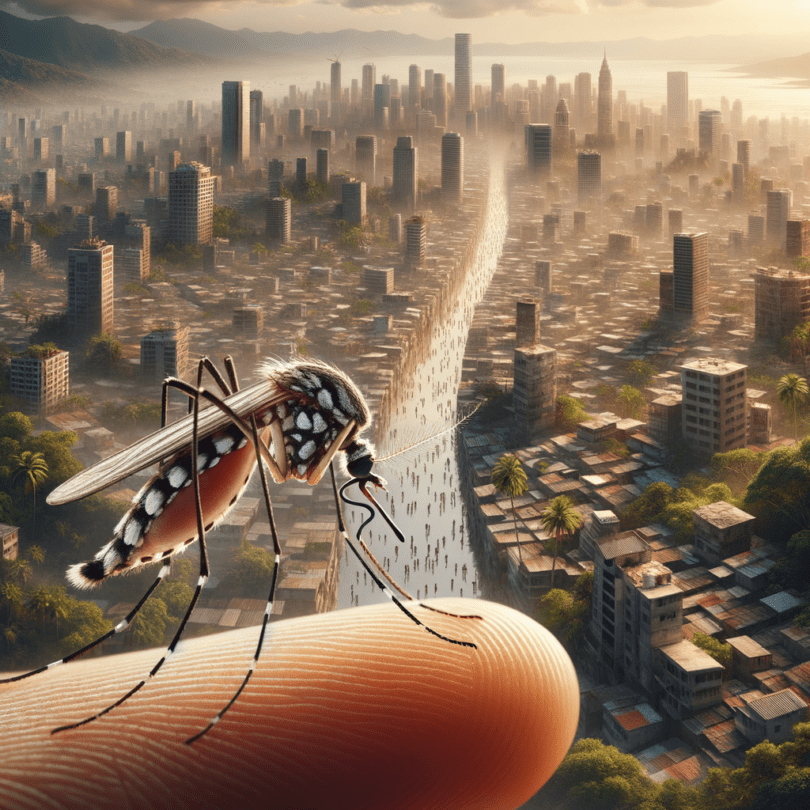As Americans prepare for the influx of mosquitoes this summer, many might wonder if they’re at risk for tropical illnesses like Zika and if climate change will increase infection rates. My colleagues and I recently conducted a study to see how future shifts in climate and human population might boost global exposure to the Aedes aegypti mosquito, responsible for spreading these viruses. We discovered that both climate change and population growth will contribute to future human exposure to Aedes aegypti worldwide. Particularly in the United States, rising temperatures due to climate change make this mosquito more common in the southern and eastern regions.
Aedes aegypti carries the viruses responsible for Zika, dengue, chikungunya, and yellow fever. An ongoing Zika outbreak in Latin America and the Caribbean has been associated with birth defects in newborns and neurological issues in adults, causing a significant public health response and attracting widespread media attention. The other three viruses are also major threats: dengue affects around 400 million people annually, chikungunya has been linked to long-term health problems like arthritis, and a recent yellow fever outbreak in Angola has raised concerns about potential vaccine shortages. Aedes aegypti is notably efficient at spreading viruses due to its reliance on humans. While many mosquitoes prefer breeding in natural settings such as wetlands, Aedes aegypti thrives in man-made water-filled containers like tires, buckets, barrels, and random trash during its aquatic life stages (egg, larvae, and pupae).
Such containers are often found in backyards, meaning adult mosquitoes end up in and around homes. Unlike some mosquito species which are not particular about their hosts, Aedes aegypti prefers biting humans. Climate affects Aedes aegypti in various ways. Warmer temperatures (up to a limit) lead to faster development during aquatic stages and higher survival rates across all stages. Precipitation, which climate change can affect, provides the water necessary for completing aquatic stages. Aedes aegypti is mainly found in warm, moist tropical and subtropical urban areas. However, it can also do well in dry desert regions, especially where humans store water in containers during droughts. In the U.S., the mosquito’s range fluctuates seasonally, as it’s at the edge of its temperature limits.
Our study sought to go beyond just using climate change projections to understand its potential future range. Such studies have been conducted previously. Instead, we aimed to estimate the number of people who might encounter the mosquito in the future, based on new population forecasts and factors related to climate change. This helped us predict how many people might be exposed to Aedes aegypti in the future and to assess the roles of climate change and population growth. Initially, we mapped Aedes aegypti’s historic range, considering the various climate conditions under which it survives, from seasonal to year-round environments. We used established data relationships between monthly temperature, precipitation, and the presence and abundance of the mosquito to create these maps. Following this, we crafted future maps of Aedes aegypti’s global patterns for 2061-2080, using projections of air temperature and precipitation.
These models relied on two potential future scenarios for air pollution and greenhouse gas pathways for the 21st century: one where greenhouse gas emissions are curbed to limit global warming to a 2-degree Celsius increase over pre-industrial levels, and another where greenhouse gas emissions rise unchecked. Lastly, we evaluated population growth under two potential future socioeconomic conditions. The “low vulnerability” scenario assumes better living standards and decreasing birth rates in poorer countries, while another “high vulnerability” scenario assumes continued low living standards and high birth rates. Based on historical data, we estimated that 63 percent of the world’s population currently encounters Aedes aegypti. To separate the effects of climate change from population trends, we modeled how exposure levels would change if the population remained at current levels (an unlikely scenario, but useful for projections). In this scenario, the percentage of humans exposed to Aedes aegypti would increase to 68-70 percent by 2061-2080, depending on emission levels, primarily driven by warming rather than changes in rainfall patterns. Considering population growth, the exposed global population percentage would rise to 71-74 percent under the lower vulnerability socioeconomic pathway. Under the higher vulnerability scenario, with continued poor living conditions and high birth rates, we found that 77-80 percent of the global population would face exposure to Aedes aegypti.
Not only would more people be exposed under the high-vulnerability scenario, but much of the population increase would occur in urban slums in developing countries in tropical and subtropical regions. These areas are ideal breeding grounds for Aedes aegypti and have high potential for virus transmission. Crucially, differences across projections are mostly due to uncertainty in how and where human populations might change, rather than uncertainty from different climate change scenarios. This highlights the need for continued research into socioeconomic factors like population growth. As is often the case, the specifics are crucial.
For example, our analysis showed that wealthier areas on the fringes of Aedes aegypti’s current range, like Australia, North America, and Europe, would benefit the most from cutting greenhouse gases. Reducing warming would limit changes to the mosquito’s range in these cooler regions. It’s important to note that the study has many limitations, specifically uncertainties related to future emissions, global political situations, mosquito control practices, human behavior, transportation systems, and competition from other mosquito species.

